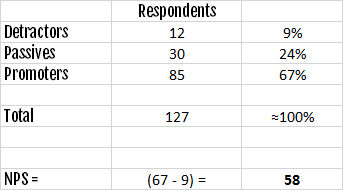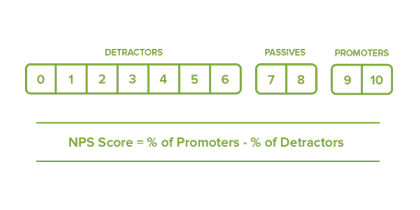The success of your SaaS company is directly tied to the ongoing satisfaction of your users, and their willingness to keep on paying for your SaaS product.
Net Promoter Score (NPS) is widely-used in SaaS, because it’s one of the simplest ways to quantify customer satisfaction with your product. However, the value of calculating your NPS is often disputed, as if it's not used correctly, it can become little more than a vanity metric.
Today I’m looking at how to calculate Net Promoter Score, and how to get real, valuable insights from this important customer success metric.
How to Calculate Net Promoter Score
The Net Promoter Score is a way to quantify customer satisfaction with your SaaS product, by asking your users one simple question:
“How likely are you to recommend [SaaS product] to a friend or colleague?”
Your users respond on a 0-10 scale, ranging from ‘not at all likely’ (0) to ‘extremely likely’ (10).
Responses fall into 3 groups:
- Detractors – users who scored you 0-6, indicating dissatisfaction with your service.
- Passives – users who scored you 7 or 8, indicating they’re reasonably satisfied with your service, but are unlikely to actively recommend it to others.
- Promoters – users who scored you 9 or 10, indicating they are very satisfied with your service, and are likely to recommend your SaaS product to others.
From there, you can calculate your Net Promoter Score by subtracting the percentage of detractors from the percentage of promoters:
NPS = %Promoters - %Detractors

A positive score suggests there are more people willing to recommend your product than those trying to discourage others from using it, and a negative score suggests the opposite.
The Problems with Net Promoter Scores
A Vanity Metric
One of the biggest problems with calculating NPS is that all too often, companies work out their ‘score’, but go no further than that. Customer satisfaction gets reduced to a single number that encapsulates customer success, and NPS becomes little more than a vanity metric.
Even worse is when companies measure NPS as a one-off, treating it like a fixed score, rather than something that will change over time as your customer base grows and your product changes.
Too Vague
Another significant problem with NPS is the lack of distinction between promoters and detractors. As a super simple example, a company with 10 promoters, 20 neutrals and 0 detractors would have the same score (+10) as a company with 20 promoters, 0 neutrals and 10 detractors.
In the first instance, customers are generally having a good experience with your product. In contrast, it’s a much more mixed picture: while two thirds of customers are likely to recommend your product, one third are against doing so. This suggests that customers are having a very inconsistent experience using your service, as your users are at two extremes.
To overcome the lack of clarity, Brandon Hickie at Openview recommends tracking promoter and detractor scores separately, in addition to tracking the overall NPS.
How to Use NPS to Get Actionable Insights
Predicting Churn
David Skok, For Entrepreneurs
Customer satisfaction is likely to be [a] good predictor of future churn.
If your customers are happy with your SaaS product, they’ll tend to keep using it. If they’re not happy with it, they won’t. Measuring NPS gives you a good sense of your customers’ overall satisfaction levels with your SaaS product.
You should treat it like a health check, and measure NPS regularly, to get an idea of how your customer satisfaction levels change over time. A sudden spike in numbers of detractors, and a sharp decline in your NPS, are sure signs that if you don’t take any remedial action, you’ll soon lose a whole bunch of customers.
Industry Benchmarking
One of the most useful things about NPS is that it’s a standardised metric, meaning that it’s easy to compare your score against those of other companies in your field.
There are hundreds of tools available to help you calculate NPS, and many of them collate customer scores and create industry-specific benchmarks from them. According to Zendesk the median NPS score for B2B companies is 29.
A Conversation Starter
It’s essential that you actually act on the findings of your Net Promoter Scores.
Your NPS surveys should be paired with personalised-follow-up questions. For example, this means you should reach out to detractors, to uncover specific problems they are having with your service, so you can identify things that need to be fixed.
Additionally, you should reach out to passives, to work out what they do or don’t like about your service, and if there’s anything that you could do better, to provide more value to them.
Finally, you should reach out to promoters, who could be good candidates for providing real user testimonials as an additional element of social proof for your SaaS product.
How Important is NPS in SaaS?
Caitlin Daily, Promoter.io
The best way to reduce or even eliminate customer churn is by continually measuring customer loyalty with NPS.
We recently asked Caitlin and 13 other SaaS experts for their best churn-beating advice, and 28% (4) of them mentioned NPS in their responses – so it’s clearly a pretty big deal. But as with all metrics, the number on its own means very little without its context.
Ryan Angilly, Ramen
When analysing customer feedback, context is king… an NPS score of 8 can mean two very different things if one comes from a relatively new user (yay!) while another comes from someone who previously rated you a 10 (womp!)
While it’s not perfect, it’s vital that you track your NPS: treat it as a starting point when you’re looking for the answer to the question: “are my customers satisfied with my product?”. From there you can dig in to the data, and gather actionable insights to help with product development, customer success, and even marketing and sales activity.








